
Trillium erectum, the red trillium, also known as wake robin, purple trillium, bethroot, or stinking benjamin, is a species of flowering plant in the family Melanthiaceae. The plant takes its common name "wake robin" by analogy with the European robin, which has a red breast heralding spring. Likewise Trillium erectum is a spring ephemeral plant whose life-cycle is synchronized with that of the forests in which it lives. It is native to the eastern United States and eastern Canada from northern Georgia to Quebec and New Brunswick.

Hydrophyllum is a genus of herbaceous perennial plants in the waterleaf family. It consists of nine species, all of which are native to North America.

Stylophorum diphyllum, commonly called the celandine poppy or wood poppy, is an herbaceous plant in the poppy family (Papaveraceae). It is native to North America, where it is found in the eastern United States and Ontario. Its typical natural habitat is moist forests over calcareous rock, particularly in ravines.
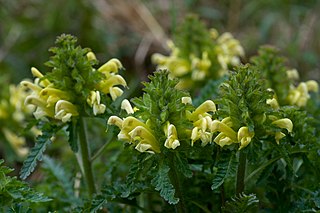
Pedicularis canadensis, commonly called Canadian lousewort or wood betony, is a flowering plant in the family Orobanchaceae. It is native to North America, where it is found in southeastern Canada, the eastern United States, and eastern Mexico. It has a wide-ranging natural habitat, being found in mesic to dry, forests, woodlands, and prairies.

Eurybia macrophylla, commonly known as the bigleaf aster, large-leaved aster, largeleaf aster or bigleaf wood aster, is an herbaceous perennial in the family Asteraceae that was formerly treated in the genus Aster. It is native to eastern North America, with a range extending from eastern and central Canada through the northeastern deciduous and mixed forests of New England and the Great Lakes region and south along the Appalachians as far as the northeastern corner of Georgia, and west as far as Minnesota, Missouri and Arkansas. The flowers appear in the late summer to early fall and show ray florets that are usually either a deep lavender or violet, but sometimes white, and disc florets that are cream-coloured or light yellow, becoming purple as they mature. It is one of the parent species of the hybrid Eurybia × herveyi.

Trillium undulatum, commonly called painted trillium, painted lady, or trille ondulé in French, is a species of flowering plant in the bunchflower family Melanthiaceae. It is also known as smiling wake robin or striped wake-robin. The specific epithet undulatum means "wavy", which refers to the wavy edges of the flower petals. The plant is found from Ontario in the north to northern Georgia in the south and from Michigan in the west to Nova Scotia in the east.

Hydrophyllum tenuipes, the Pacific waterleaf, is an herbaceous perennial plant native to North America. It is found in western North America from British Columbia to northern California.
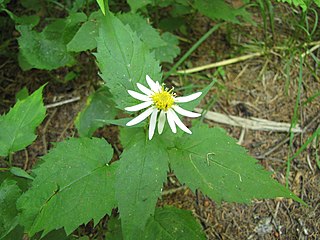
Eurybia chlorolepis, commonly known as the mountain wood aster, mountain aster, or Appalachian heartleaf aster, is a perennial, herbaceous plant native to the southeastern United States. It is present only at relatively high elevations in the Appalachian mountains. Although it is not considered seriously threatened due to a large number of sites in some of its range, it is often locally endangered and possibly extirpated in the south of its range.

Eutrochium purpureum, commonly known as purple Joe-Pye weed or sweetscented joe pye weed, is an herbaceous perennial plant in the family Asteraceae. It is native to eastern and central North America, from Ontario east to New Hampshire and south as far as Florida, Louisiana, and Oklahoma.

Trillium pusillum is a species of flowering plant in the family Melanthiaceae known by the common names dwarf trillium, least trillium and dwarf wakerobin. It is native to the southeastern and south-central United States from Oklahoma to Maryland.
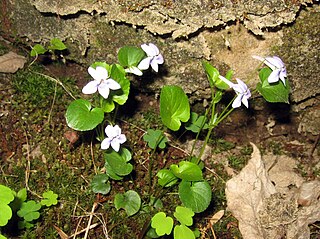
Viola rostrata, commonly called the long-spurred violet, is an herbaceous plant in the violet family (Violaceae). It is native to eastern North America, where it is found in Canada and the United States, primarily in the Northeastern, Midwestern, and Appalachian regions. Its natural habitat is acidic mesic forests, often growing near Tsuga canadensis.

Clintonia umbellulata, commonly known as white clintonia or speckled wood-lily, is a species of flowering plant in the lily family Liliaceae. The specific epithet umbellulata means "umbelled," which refers to the shape of the plant’s inflorescence.
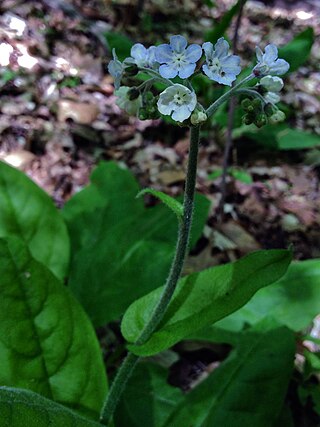
Andersonglossum virginianum, known as southern wild comfrey, is a flowering plant in the borage family native to North America. It is also sometimes called blue houndstongue.

Hydrophyllum appendiculatum, commonly known as great waterleaf, appendage waterleaf, or woolen breeches, is a species of plant in the Boraginaceae (borage) family. It is native to central and eastern North America where it is found primarily in the Midwest and Upper South of the United States. It is a biennial that produces lavender-colored flowers in late spring and early summer.
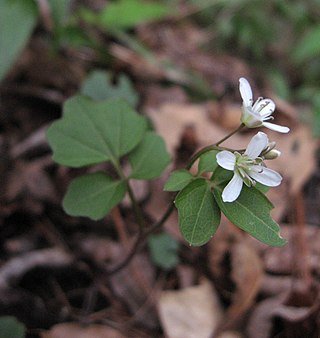
Cardamine flagellifera, commonly known as Blue Ridge bittercress, is a species of herbaceous plant in the mustard family. It is native to eastern North America, where it is found primarily in the southern Blue Ridge. It is a perennial that produces white flowers in the spring.

Stachys hispida, commonly known as hispid hedgenettle, is a species of flowering plant in the mint family (Lamiaceae). It is native to eastern North America, where it is found in Canada and the United States. Its natural habitat is in moist areas, such as alluvial banks, bottomland forests, and wet meadows.

Viola sagittata, commonly called the arrowleaf violet, is a species of flowering plant in the violet family (Violaceae). It is native to the eastern North America in Canada and the United States, where it is widespread. It is found in a variety of natural habitats, but is most common in dry, open communities such as prairies, glades, or woodlands, often in sandy or rocky soil.

Myosotis macrosperma, commonly called largeseed forget-me-not, is a species of flowering plant in the borage family (Boraginaceae). It is native to North America, where it found in the eastern United States and Ontario, Canada. It is found in a wide variety of natural habitats, including areas of bottomland forests, mesic forests, and prairies. It appears to be associated with nutrient rich soils. It is tolerant of disturbance, and can be found in highly degraded communities such as pastures and fallow fields.
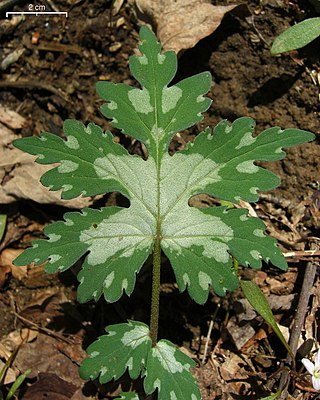
Hydrophyllum canadense, known as bluntleaf waterleaf, broadleaf waterleaf, or Canada waterleaf, is a flowering plant in the borage family, Boraginaceae. It is native to the eastern United States and Canada.

Thaspium trifoliatum, commonly called meadow-parsnip or purple meadow-parsnip is a species of flowering plant in the carrot family (Apiaceae). It is native to eastern North America where it is found in many eastern U.S states and in Ontario, Canada. It has a broad natural habitat, which includes mesic to dry forests and woodlands, prairies, bluffs, and rock outcrops.





















